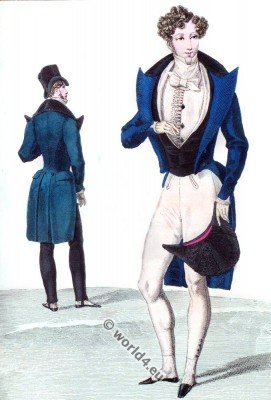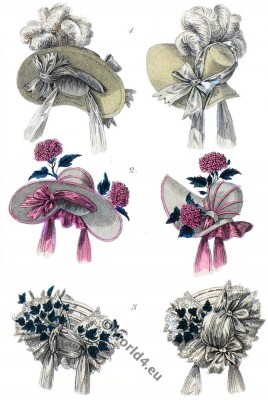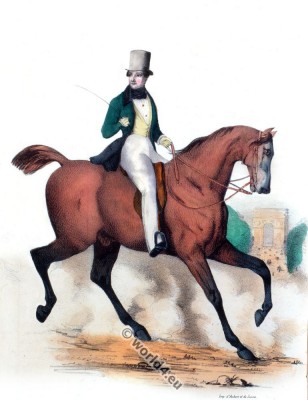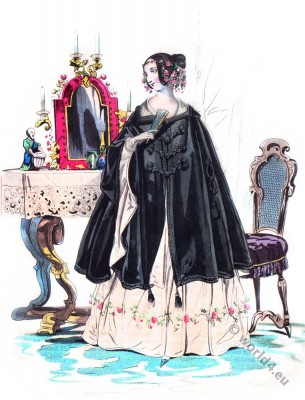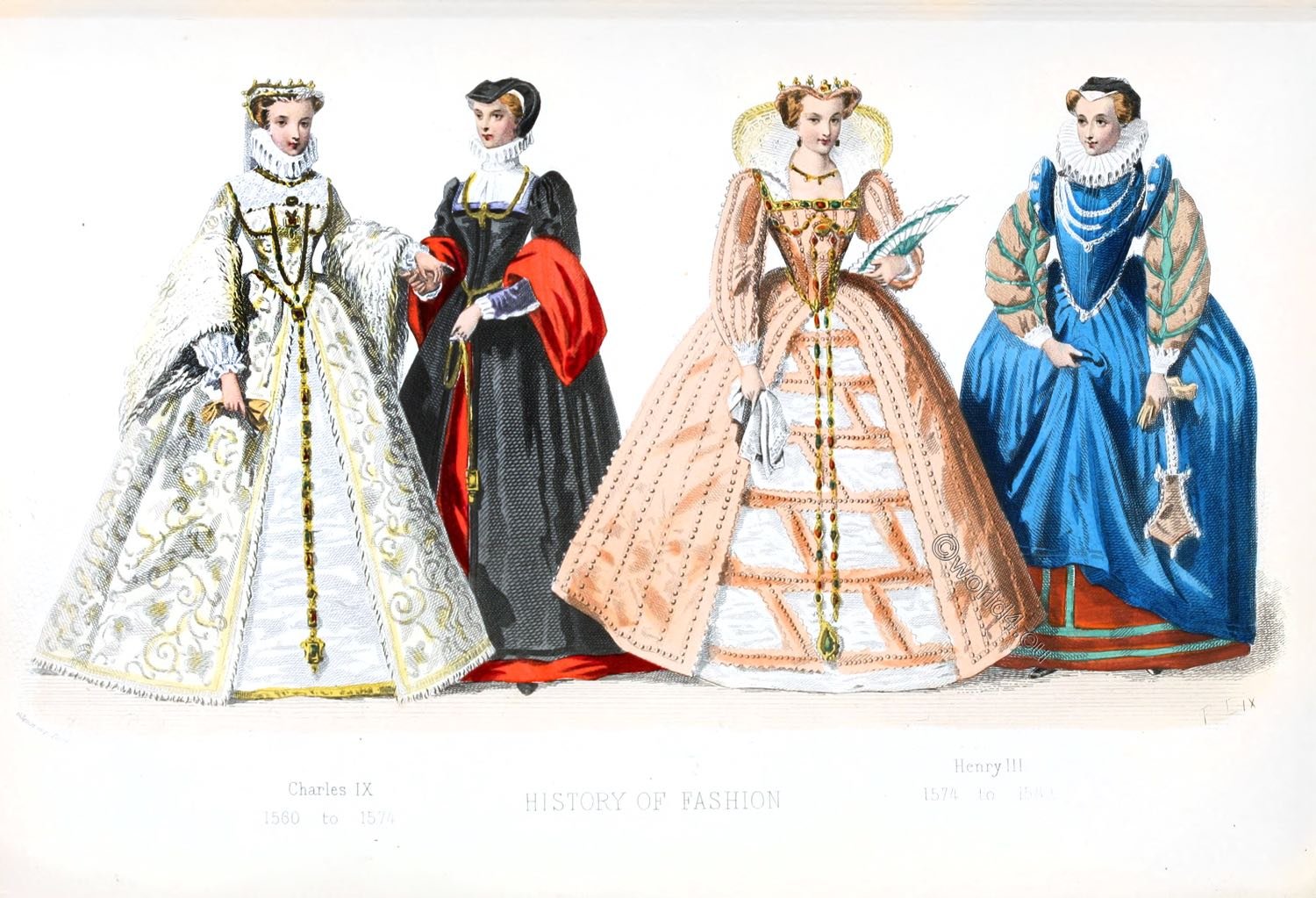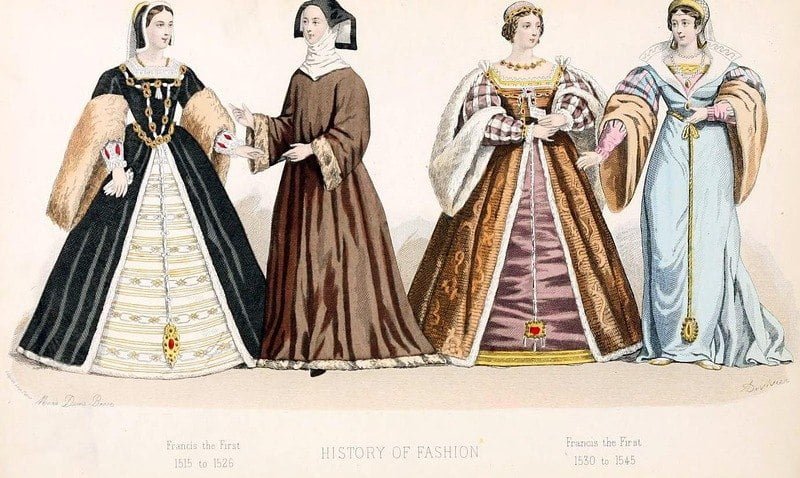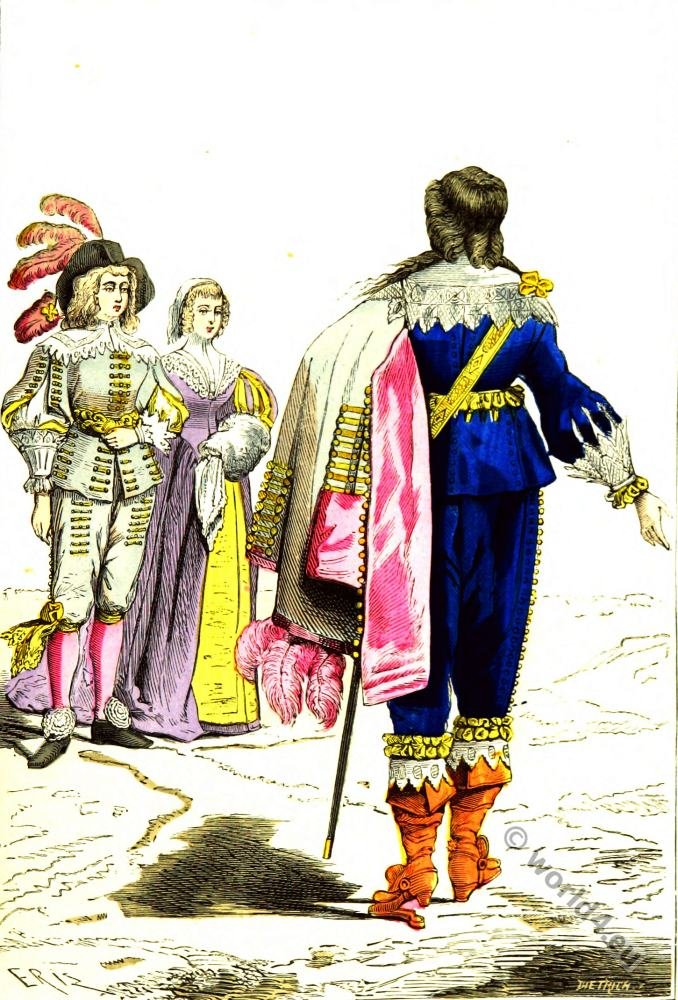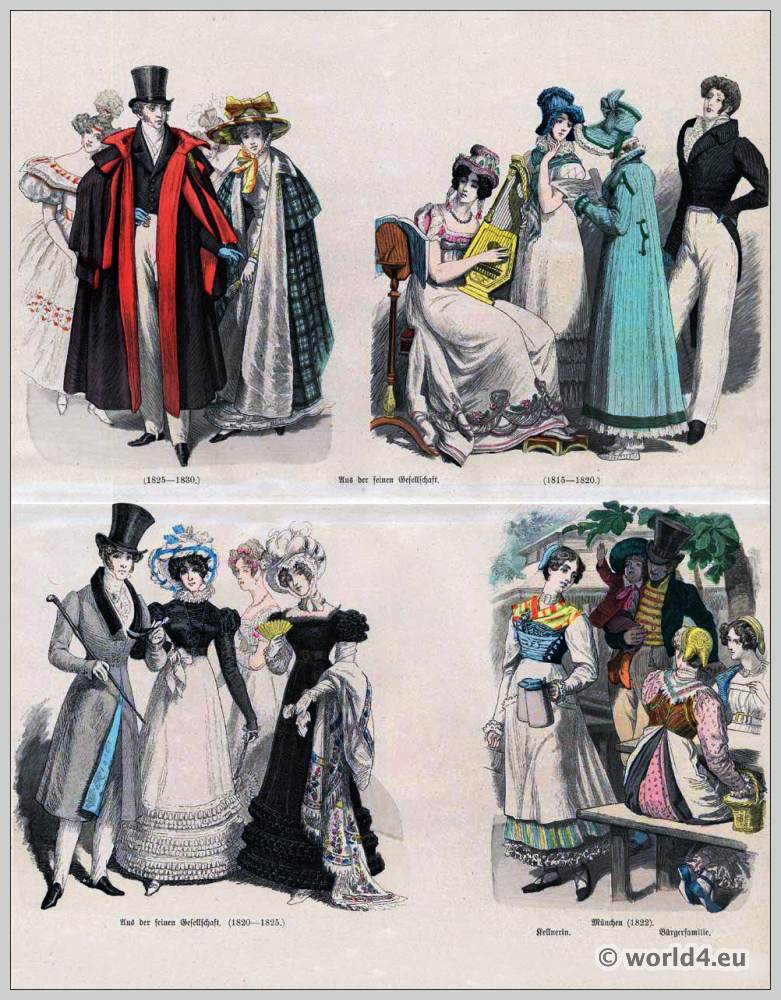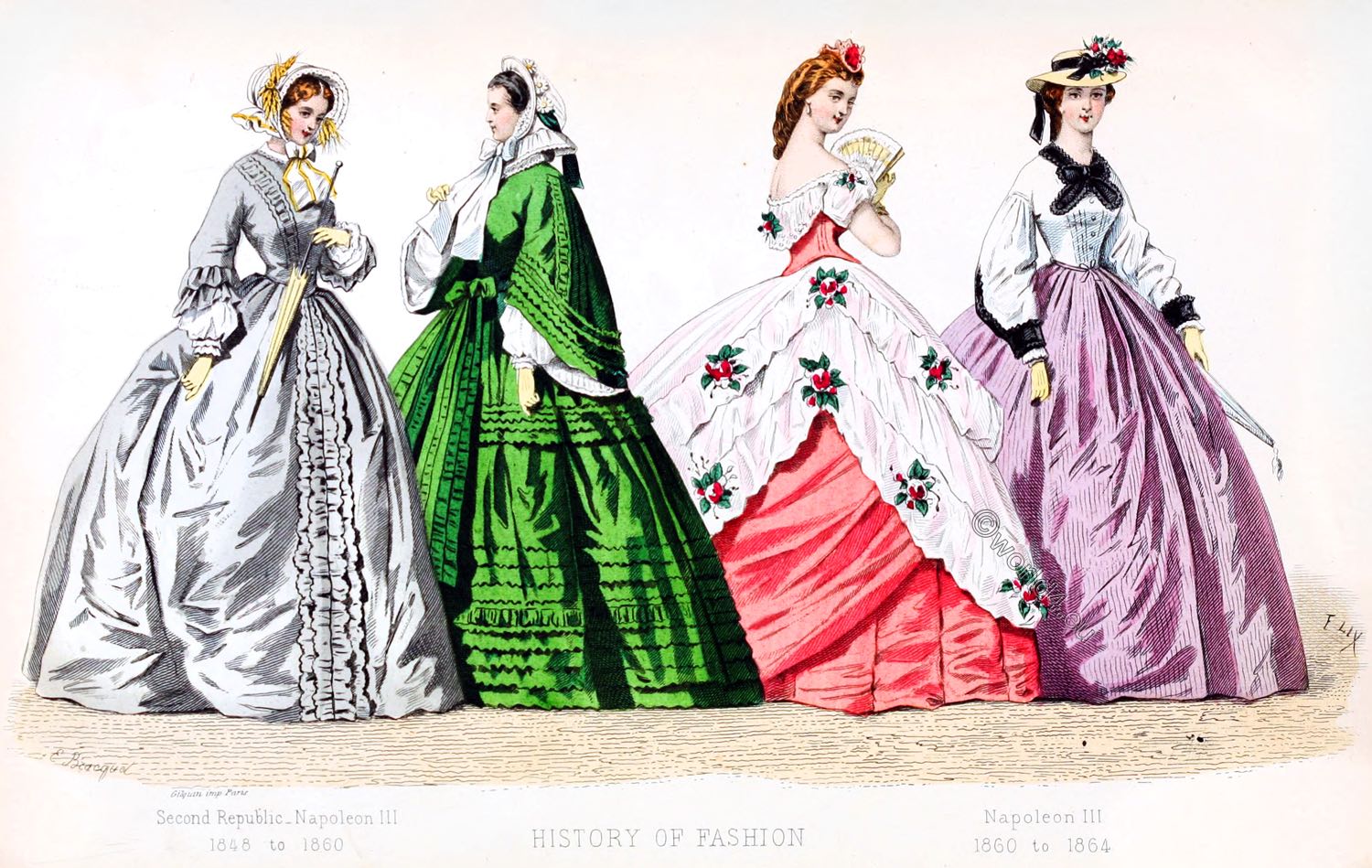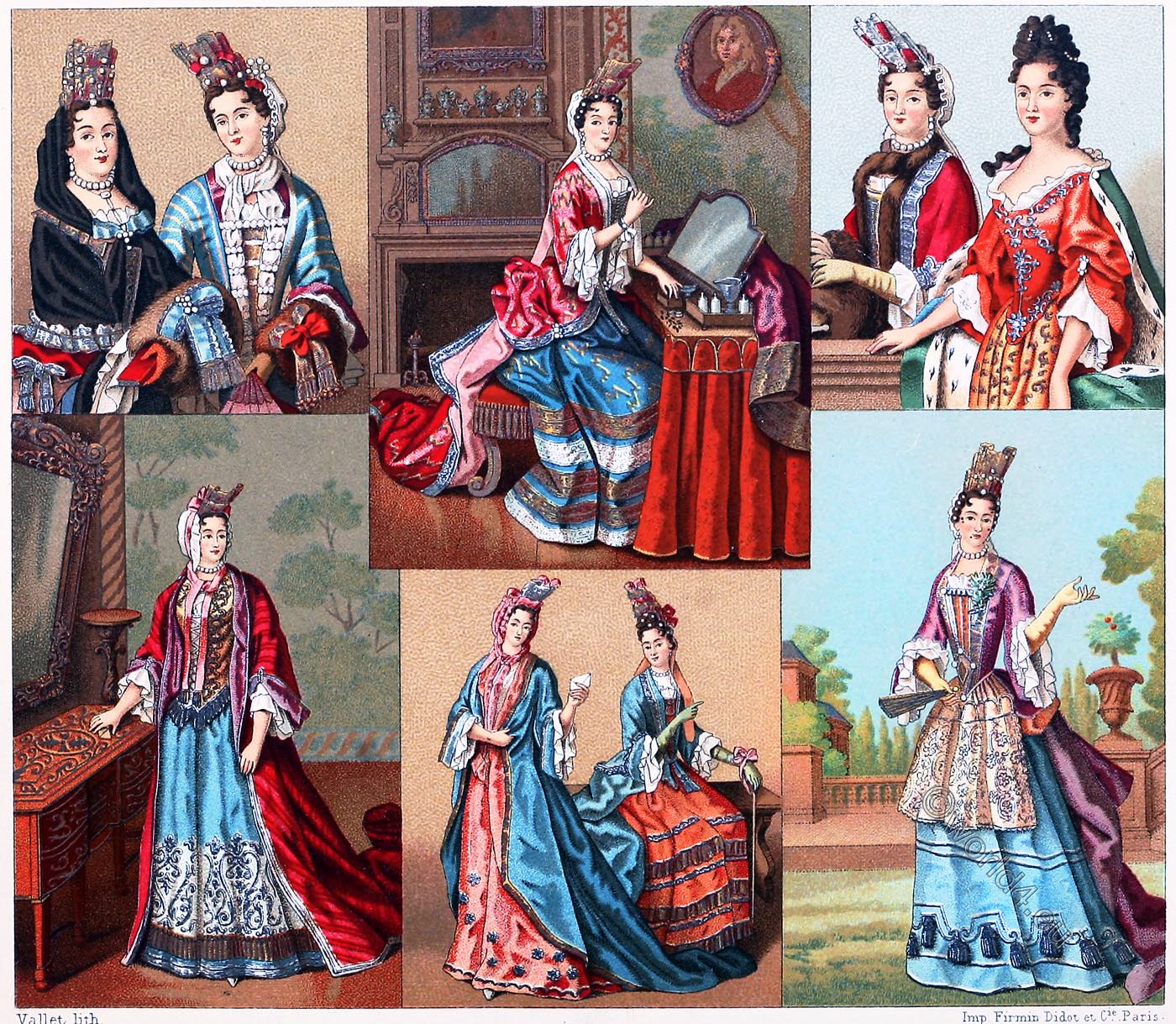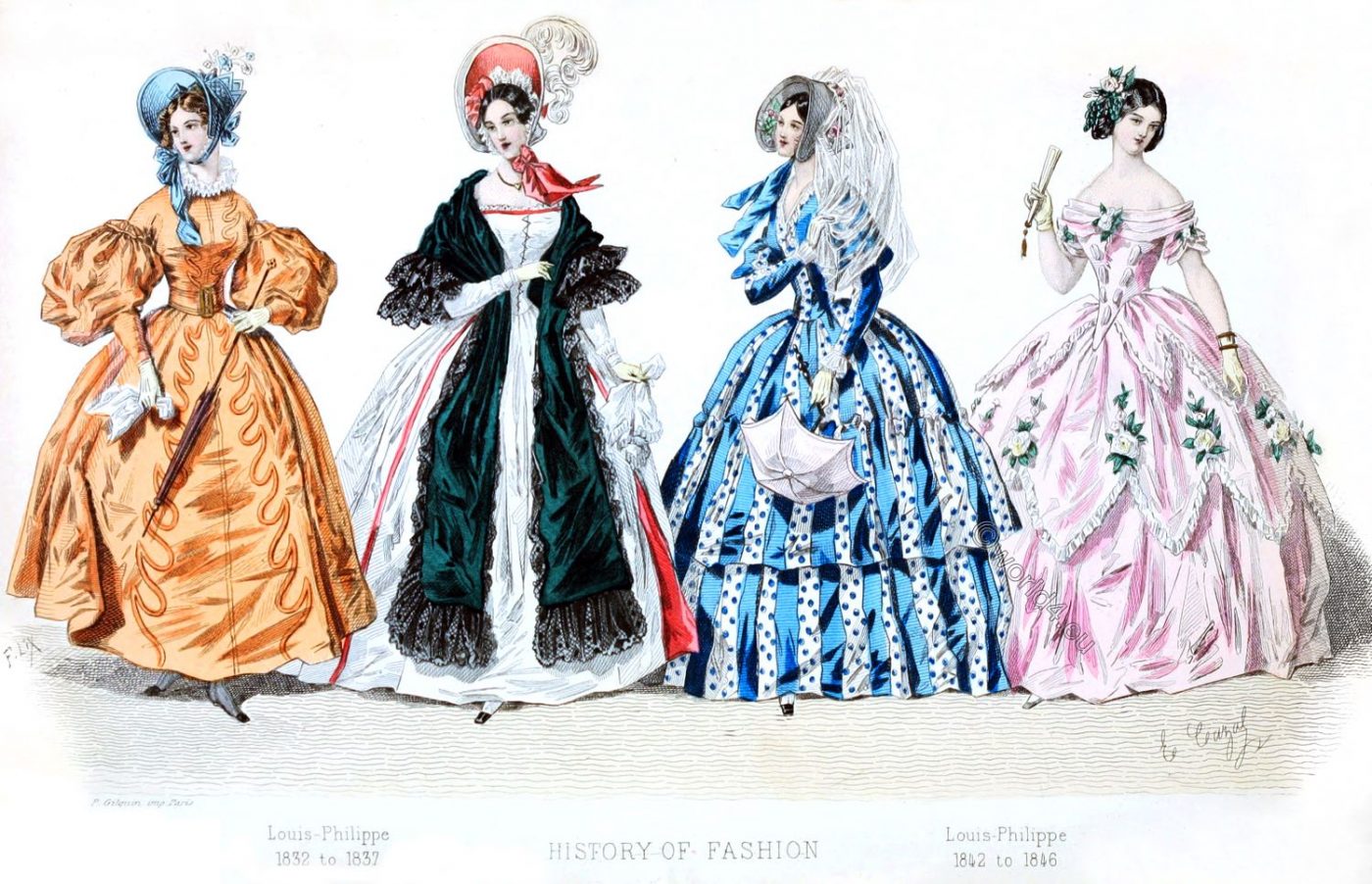
Romantic fashion in the Reign of Philippe. 1830 to 1848.
Romantic era, German Biedermeier.
The Revolution of July, 1830 — Fashions in Louis Philippe’s reign — Microscopical bonnets, called “bibis,” “cabriolets” — Variety of caps — Fashions of the Middle Ages and of the Renaissance — The stage — Historic costumes — Influence of Rachel, the actress — Greek and Roman fashions — Colours — Various designations of materials — Bedouin sleeves — Bonnets and head-dresses — Pamela bonnets — Novel eccentricities — Taglioni gowns, gathered “4 la Vierge,” laced “à la Niobe,” &c. — The “Sylvestrine” — Costumes to be worn on occasions of attempts on the king’s life — Bouquets for balls.
Fashions in Louis Philippe’s reign
The Revolution of July 1830 did not produce nearly so much effect on dress as that of 1789.
In the reign of Louis-Philippe I. (1773 – 1850), as in that of Charles X., feminine costume changed but little. Fanciful adjuncts of dress succeeded one another without interruption, but the basis of dress in general remained the same. Microscopical “bibs” took the place of the enormous bonnets that under the name of “cabriolets” had been the delight of Parisian ladies in 1835; and dress-caps were manufactured in a variety of shapes, and under a variety of names, viz. the Charlotte Corday, the peasant, the nun, the Elizabeth, the chatelaine, the Marie Antoinette, the polka, &c.
Microscopical bonnets. Variety of caps.
But the only striking novelties were the nets “à la Napolitaine,” the “steeple-chase” rosettes placed below the ears, the Armenian toques “à pentes” (or sloping), the Catalan half-caps, the fringed Algerian head-dresses, and the white and gold Jewish turbans with strings “à la Rachel.” These turbans were taken from Mdlle. Falcon’s stage dress in Halevy’s opera of “La Juive.”
The greatest novelty consisted in the colours chosen for dress. The “Snow” head-dress was named after Auber’s work; gowns “à la Dame Blanche,” after that of Boieldieu; and caps “à la Fiancée,” also after Auber. To these succeeded various colours, called “Solitaire,” from Carafa, or the ” Petites Danaïdes,” and “Robin des Bois.” Dark and sober tints were worn in preference to brighter hues, for no other reason than the romantic ideas of a period in which both men and women delighted in appearing melancholy, Byronic, and sickly.
The effect of the Romantic School on Fashion may be easily imagined. The early works of Victor Hugo and Lamartine had kindled the popular imagination, while Scott’s novels and Byron’s poems had everywhere fostered ideal sentiments. Reveries, suffering, sacrifice, and boundless self-devotion were the themes of the day, and fair ladies voluntarily shed tears, because to weep was fashionable.
I, the writer of these lines, have known many young girls quite distressed by their healthy appearance, their rosy cheeks, and fresh complexions. “It looked so common,” they said. As if the brilliant colouring of nature were not the incomparable source of all beauty. More than one young girl who longed to look consumptive, ended by becoming so in reality, by dint of depriving herself of proper nourishment, which she feared might make her grow stout and “material.”
Fashions of the Middle Ages and of the Renaissance
The return to the Middle Ages was likewise manifested by numerous costumes taken from the periods of which we treated at the beginning of this history.
Who is that lady? Is she the Le Châtelain de Coucy? She wears a long train, an enormous pearl necklace, and hanging sleeves like those of Marguerite of Burgundy; the alms-bag suspended from her waist, and her carved jewellery, make her resemble a woman of the fourteenth century. Not so, however. She is the wife of a rich shopkeeper, and has been present at the performances of plays by Victor Hugo and Alexandre Dumas.
Does not that other fair lady belong to the court of Charles VI.? No; you make a mistake. She has only insisted on her milliner dressing her like Mdlle. Georges in her stage dress of Isabeau de Bavière, the principal character in the play of “Perrinet Leclerc.”
The stage — Historic costumes.
Not only the public resorts of Longchamps and the Tuilleries, but the French and Italian Opera Houses, the Opera Comique, the Théâtre-Français, and the large theatres of the Boulevards exercise the greatest influence at the present day over the caprices of Fashion. An extraordinary discrepancy exists between the character of women and the garments they choose to wear. A sweet and gentle girl has her hair dressed like that of the infanticide Norma, and the best of mothers seeks to imitate the costume of that arch-poisoner, the Marquise de Brinvilliers.
Masked and fancy-dress balls were crowded with historical characters, from Frédégonde to Mary Stuart, and from Catherine de Médicis to Charlotte Corday. The Greek and Roman styles were replaced by those of the Middle Ages and the Renaissance.
We find the following paragraph in a Review of 1834: “Fashions, like Empires, have their Revolutions, which in former times were slow and gradual; but at the present day they follow the spirit of the age, and share in its instability. Each century was formerly stamped in the same image, and the dress of our forefathers might have served, in a certain sense, to mark the dates of our history. But at the present day. Fashion, greedily seeking after novelty, appeals to every era and every period, borrowing from each, and only takes possession of one costume in order to throw it aside for another, in a few months, or weeks, or even days.”
Influence of Rachel, the actress.
Meanwhile the great actress, Rachel, revived the ancient tragedies. She played successively Emilia, Hermione, Eriphyla, Monima, Electra, Roxana, Paulina, Agrippina, and Phædra, and by her genius gave new life to masterpieces that had been almost forgotten, if not despised, since Talma ceased to interpret them. Thereupon the ladies of the Faubourg St. Germain and those of the Chaussée d’Antin became fired with enthusiasm; not only did they invite Rachel to their salons, where she recited the imprecation of Camilla or the dream of Athalia, but they copied the dress of the illustrious tragedian. If Rachel wore a bracelet of artistic design, other ladies immediately tried to procure similar ornaments; or if on another occasion she displayed a set of magnificent cameos, they too must possess cameos of the same kind. They copied the great actress in the minutest detail of her costume, and even in her most characteristic head-dress.
The Romantic School was succeeded by that of “good sense,” according to the admirers of Ponsard; and Emile Augier’s “Ciguë” produced a temporary revival of the taste for Greek and Roman fashions.
But the reaction against the Middle Ages did not reach the “bourgeois” classes, who, when their “romanticist” costumes were worn out, replaced them with others of a less striking style, and better adapted to modern life.
With regard to the colors most generally worn during the reign of Louis Philippe, we may mention Russian green, wine-lees, Marengo black, and pure Ethiopian, as succeeding to the delightful hues of lilac, pigeon-breast, and “early dawn.”
And by how many extraordinary designations were the new materials known! How charming was that of pou de sire, or pou de la rein(Silk louse. Queen’s louse.)!
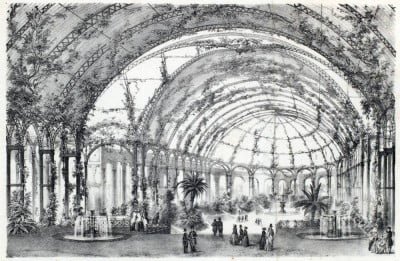
Colors — Various designations of materials — Bedouin sleeves.
Never had there been such a variety of nomenclature! The most wonderful appellations were bestowed either by the manufacturers or the vendors of the new materials, and the public seriously accepted and made use of the pretentious newly-invented words, at which sensible people could but smile.
To “diamantines” were added “constellées,” and to “Venus’s hair” succeeded “butterflies’ wings.” How poetical! what romantic garments
We are omitting to mention the tricolor materials, that made a momentary appearance from time to time, when patriotism happened to be awakened by some victory over the tribes of Algeria.
Besides poetical names, there were others less agreeable, but accepted universally nevertheless. It sounded odd to compliment a lady on her Bedouin sleeves, or her busked or loosely-laced bodice!
Bonnets and head-dresses — Pamela bonnets.
Head coverings underwent singular changes. The “bibi” was suddenly transformed into the “cabas,” with a deep crown concealing the neck; and the next season brought in Pamela bonnets, with rounded brims, that very prettily revealed the outlines of the cheeks. The hair was, generally speaking, arranged in curls on each side, and in large rolls held by a comb at the back of the head.
Almost all family portraits of that date represent the hair arranged thus, and adorned either with feathers or more frequently with artificial flowers, such as are still worn. Great perfection had been attained in the manufacture of roses, geraniums, nympheas, chrysanthemums, camelias, and many other lovely flowers, to enliven the attire of women.
The most fashionable style of dress in 1830 was as follows:— Gowns either high or low, with or without capes; long sleeves with wristbands, or short sleeves and long gloves; bodice with or without a waistband, and generally worn with an embroidered collar; scarf and parasol of some dark tint; black prunella or Turkish satin shoes; no trimmings to the gown, but red or flame-colored ribbon bows scattered here and there; and necklaces composed of two rows of pearls.
But we must not imagine that this was all, and that capriciousness and the love of change can ever abdicate their throne. The “leg-of-mutton,” the “berêt,” the “imbecile,” and the “elephant” sleeves were succeeded by others not quite so eccentric, but still, for the most part, sufficiently extraordinary.
Such were the “Venetian,” the “Louis XIII.,” the “nun’s,” the “Turkish,” the “Bedouin,” the “Persian,” the “gardener’s,” the “Sevigné,” the “Dubarry” sleeves, &c. I omit some of the strangest. Henry the Second’s narrow-brimmed hats with curled feathers came again into fashion, and the ladies adopted enthusiastically collars and “guimpes” à la Médicis, and mantles “à la vieille” (Old woman) or “à la paysanne.”(Peasant woman.)
It would be an endless task to enumerate the slight but very various developments of fashion. Yet I must mention the “Taglioni gowns,” consisting of four skirts; nor can I omit speaking of “berthes” of blond, “Célimènes,” Pompadour bodices, Niobe lacings, plaitings “à la Vierge,” Grecian and pointed bodices, &c.
Numberless new materials were produced; among them were “droguet Catalan,” “lampas burgrave,” “Polar star,” “blossoming chameleon,” “casimirienne,” “palmyrienne”— a blue ground brocaded with gold, “Benvenuto Cellini” blue velvet, “Medici” and “Louis XV.” satins, “tulle illusion,” “Rachel” crape, “cameline” silk, a tissue called “fil de la Vierge,” “polka” gauze, and, lastly, “Duchess” and “Fleur de Marie” pocket handkerchiefs.
The “Sylvestrine”.
In 1839 a manufacturer invented “sylvestrine,” a material composed of the thinnest possible layers of wood; these formed the surface of a light and flexible sheet of pasteboard. Another invented a material of spun glass. Great ladies delighted in lace. The wedding gown of the Princess Helene, Duchesse d’Orleans, was of Alençon point, and cost thirty thousand francs.
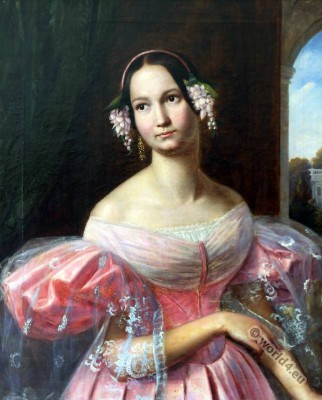
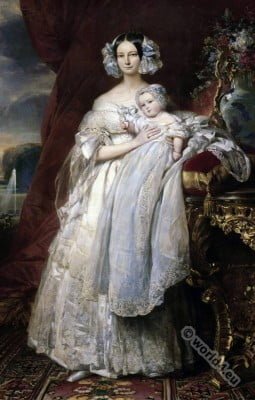
How many different names have since then appeared in the Calendar of Fashion! Each recurring season has witnessed the birth and death of something new in head-dresses or dress materials, or some fanciful caprice or new shape in garments. The beautiful Mmc. de Sampajo, the attached friend of Louis Philippe and his family, was enumerating, on one occasion, all the costumes she provided herself with at the beginning of each year.
“I was forgetting,” she said, “to mention my dress for the days on which the king or his family are fired at. …”
It is a fact that regicides abounded under the Monarchy of July; and as often as Louis Philippe escaped unhurt from some attempt on his life, ladies would hastily dress themselves in some simply shaped, dark-coloured costume, and present themselves at the Tuileries, to offer him their congratulations.
Such costumes were always kept in readiness in a wardrobe, and were known as “costumes for days on which the king’s life is attempted.”
In the annals of fashion, the reign of Louis Philippe is remarkable only for “romantic costume” at first, and afterwards for the “classical costume” inspired by Rachel. It must not be inferred, however, that the reign of Fancy had ceased to exist.
Many trifles, light and fragile as roses, exist like roses, for one day only. And every woman is the willing slave of Fashion, however extraordinary it may be, so that by dressing like others, she may avoid the appearance of singularity.
Bouquets for balls.
A sort of rivalry existed in 1834, concerning bouquets for balls. Five or six camelias, mixed with green leaves, were placed in the centre of a pyramidal nosegay consisting of violets, ferns, and small hot-house flowers. These bouquets were placed in a gilt or jewelled holder, to which was attached a ring and chain; the bouquet, therefore, might be allowed to fall, and would yet remain suspended to the finger.
Source: The history of fashion in France, or, The dress of women from the Gallo-Roman period to the present time by Augustin Challamel, Frances Cashel Hoey, John Lillie. Publisher: New York, Scribner and Welford, 1882.
Related
Discover more from World4 Costume Culture History
Subscribe to get the latest posts sent to your email.


